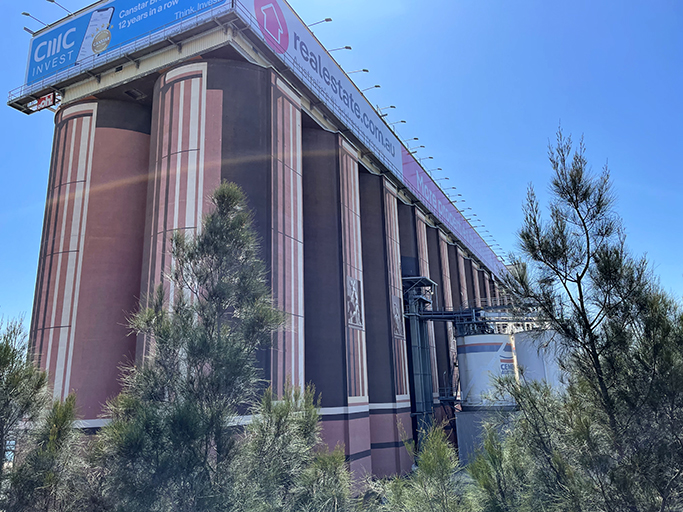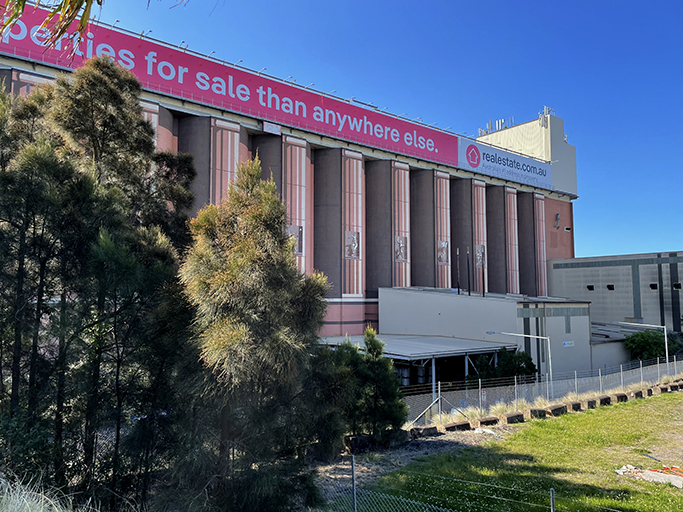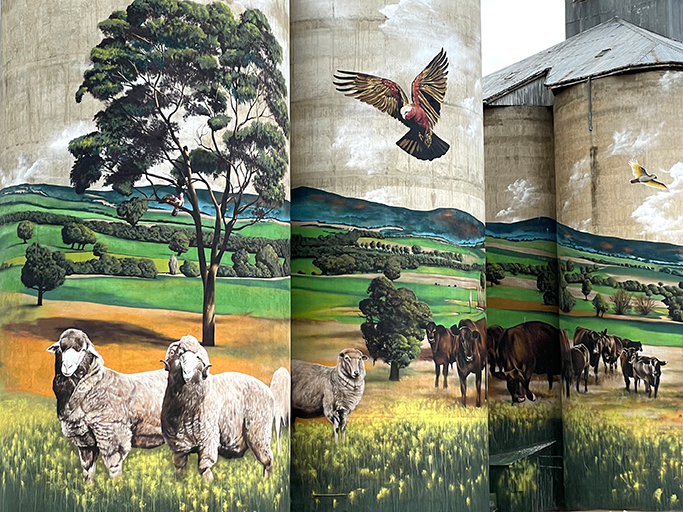
Silo Art
Art on a grand scale
Travelling around the Australian outback, every now and then you will come across huge water tanks and grain silos that have been transformed from utilitarian structures into spectacular canvases inspired by their local community. These amazing feats of logistics aren’t just beautiful, they have seen many drought-affected rural towns and communities find new life as outdoor art galleries and helped to promote tourism across regional Australia.
Silo art is a relatively new phenomenon in Australia with our first silo painted by American artist Hense and British muralist Phlegm in 2015 in Northam, Western Australia. Since then, silo art projects have sprung up across Victoria, South Australia, Queensland and New South Wales – with over 50 painted silos, more than 100 painted water towers, and many more projects in the pipeline.
My love of silo art has only just begun, and I feel there may be some conversations to be had with my better half about how far is too far to detour to see a silo. Below are the awe inspiring artworks that we have come across on our travels so far. As we hunt down more, I will add them to the list and hopefully inspire others to seek out these beautiful works of art.
A comprehensive list of art locations including mural towns and rural galleries can be found at the Australian Silo Art trail
Merriwa
Location: Grain Corp Silos, Merriwa, NSW
Artist: David Lee Pereira
Completed: 2019
A sheep wearing red socks and running through a field of canola is not what you expect to see staring down at you from the side of a grain silo, and one might wonder, as we did, why are the sheep wearing red socks?
It’s the running of the sheep. Every year on the June long weekend, Merriwa hosts the Festival of the Fleeces which raises much-needed funds for local charities. The festival was established to promote the best that Merriwa has to offer, with a focus on the history of the Merino Sheep and how the wool industry has helped shape their community. The ‘Running of the Sheep’ is held on the Saturday, when you can see the real live sheep wearing red socks making their way down the main street. Why red socks? One year when a regular sponsor couldn’t afford to give money they offered to donate red socks. For lack of any better ideas the socks were put on the sheep, and a new tradition was born.
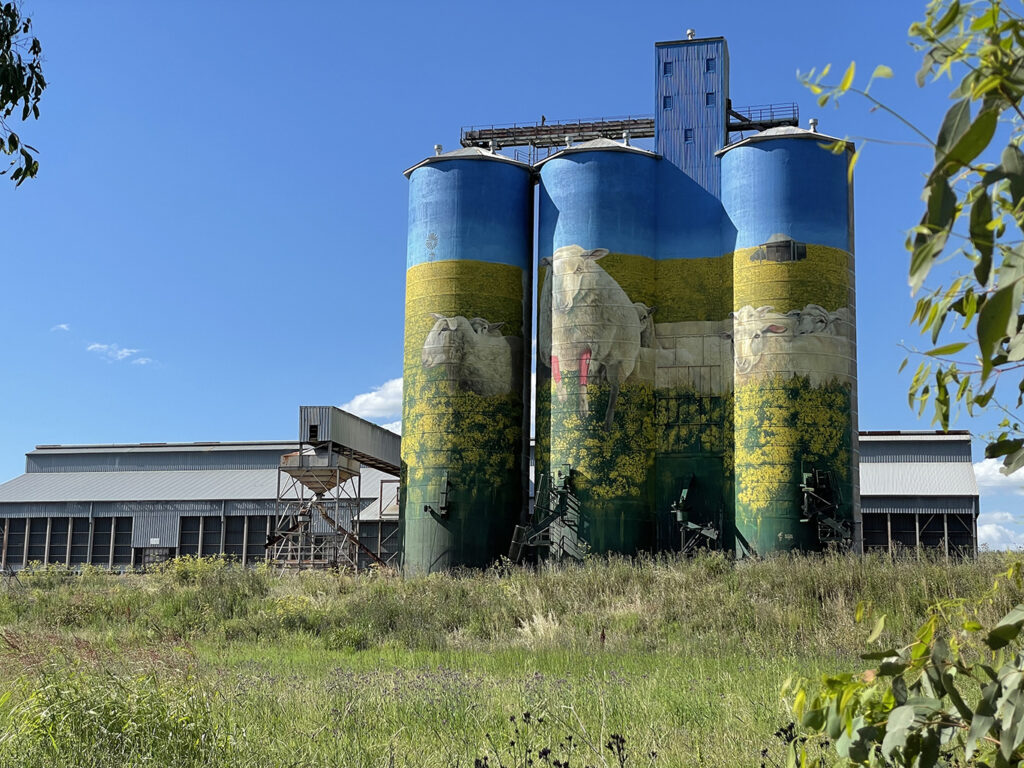
Back to the Silos…
This was David’s first silo mural creation and reputedly used 280 litres of paint and 160 litres of primer. He was inspired to create an artwork that was distinctive of Merriwa, unique to the site and represented something the community would be proud of. He certainly achieved that.
Despite their size, and the red socks, it is easy to miss these silos as you drive through town. Sitting on the northern side of the railway line, the best vantage point is Hacketts Road. Turn off the Golden Highway down Quigley Street, next to the skate park. There is plenty of space to pull up along the side of Hacketts Road while you admire the woolly sock wearers, and when you are done you can continue along the road back into town.
Dunedoo
Location: Castlereagh Highway, Dunedoo, NSW
Artist: Peter Mortimore and Daniel Krause
Completed: 2020 (Peter Mortimore) and 2021 (Danial Krause)
Standing proudly in the centre of town these silos are privately owned, with funding for the art project coming from a government grant. They were painted in stages by two different artists.
On the eastern side of the silo Peter Mortimore has depicted Dunedoo’s favourite son, jockey Hugh Bowman. He sits astride his most famous ride, champion racehorse Winx and alongside them is Winx’s trainer Chris Waller. Peter has painted many a horse on canvas, but this is by far his biggest equine art project. The name Dunedoo is derived from the Wiradjuri language for Black Swan and these graceful creatures are featured on the southern and western sides of the silo, soaring over the local rural landscape.

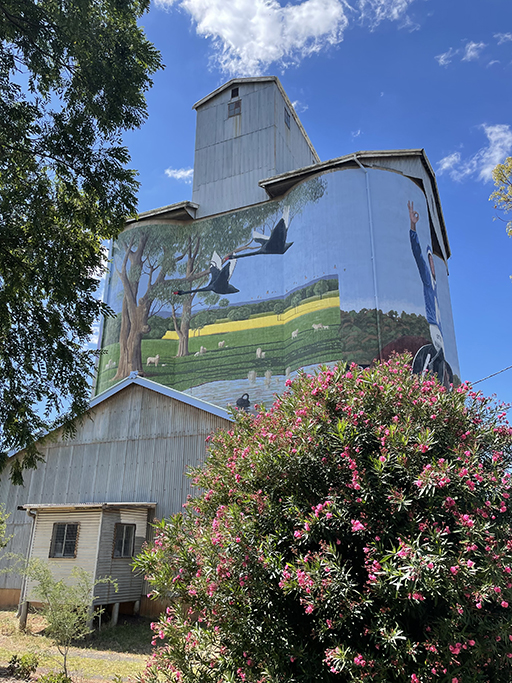

Daniel Krause painted the northern end of the Dunedoo Silos with a likeness of his son reading a book in a wheat field, framed by a most spectacular country sunset.
The Dunedoo Silo is on Castlereagh Highway right next to the Lions Park with plenty of parking, even for those of us towing a van. There are public toilets in the park and a great looking bakery over the road.
Murrumburrah Mill
Location: Albury Street in the twin towns of Harden and Murrumburrah
Artist: Heesco Khosnaran
Completed: 2021
After some delays due to Covid, Melbourne-based Mongolian street artist, Heesco, completed this silo art in 2021. The silo depicts the mill’s history and the grain industry that the town was built on.


The original flour mill was built in 1865, and then rebuilt in 1919-1922 after damage from a major fire. In 1991 the silos were mothballed, and they sat empty for several decades until their transformation into a work of art.
The best view of the murals is from Lyons Street, looking over the property on the corner. You will have to stagger up a small slope to the fence, and the residents have planted a row of trees which threaten to block the view. I can only assume they were not thrilled with the towns new tourist attraction bringing a constant stream of onlookers to their side fence.
There is some street parking in Lyons Street but not enough if you are towing. Roberts Park on the corner of Neill and Iris Streets may provide a better option for caravaners.
Grenfell
Location: 42 West Street, on the corner of South and West Streets.
Artist: Heesco Khosnaran
Completed: 2019
Grenfell Commodities silos have been a part of local history since 1925, and still operate today, filling with grain at harvest time every year. Inspired by the Weethalle Silos, Grenfell Commodities privately commissioned Melbourne-based muralist Heesco to transform the Grenfell silos into a canvas which reflects the local Shire.
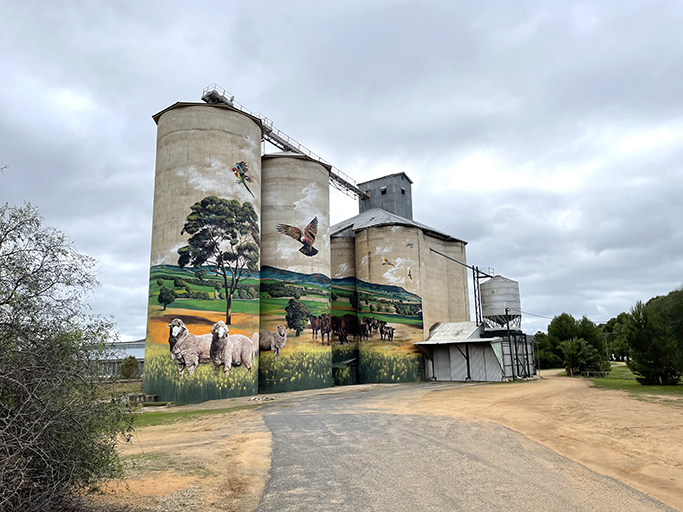
The four concrete silos are painted as one continuous mural of the local farming landscape, Heesco’s design is based on work by local photographer Denise Yates. Sheep and cattle sit in front of a backdrop of the Weddin Mountains National Park with native birds flying overhead. Over five weeks, 800 cans of spray paint and 130 litres of acrylic paint makes this Heesco’s largest work to date.
Plenty of parking and easy access for these silos, and don’t forget to check out the Big Pick and Pan while you are in town.
Gunnedah
Location: 2 Barber Street, Gunnedah.
Artist: Heesco Khosnaran
Completed: 2020
Gunnedah Silo Art is near the northern end of town, on the corner of Barber and New Streets, There is plenty of room to park and a grassy area you can view the silo from. Maize Mill is still a working silo and as such is fenced off to the public so you will be looking at it through the fence. There is apparently a viewing platform on the side of the bridge where Warrabungle Street crosses the railway line, I missed that opportunity, guess I will have to go back!


This mural is another of Hescos master pieces. Painted in 2020 It is a tribute to the famous Australian poet Dorothea MacKeller. A verse from her poem ‘Sunburnt Country’ is emblazoned on the Silo along with her portrait and other imagery from the poem. We visited here at the beginning of a seven week road trip around Queensland so her words rang very true for me…
I love a sunburnt country,
A land of sweeping plains,
Of ragged mountain ranges,
Of droughts and flooding rains.
I love her far horizons,
I love her jewel-sea,
Her beauty and her terror —
The wide brown land for me!
Thallon, QLD
Location: Noondoo-Thallon Road, Thallon
Artist: Joel Fergie and Travis Vinson
Completed: 2017
This tiny country town is home to Queensland’s first silo art project. Initiated to raise community spirits, and create a cultural tourism attraction, this stunning artwork was 2 years in the planning. The final painting was completed over three weeks by two Brisbane-based artists, Travis Vinson (known as Drapl) and Joel Fergie (known as The Zookeeper).
The Watering Hole was inspired by images captured by three local photographers. The sheep at first light, the Moonie River and the pale face rosellas were combined with other local icons to create an A4 drawing that was translated to fill the massive 30 x 40 metre silos.
The official viewing area for the Thallon Silo is on William Street and is quite well signposted as you drive through town. There is plenty of parking and an information board at the top of an embankment from which you can snap your pics.
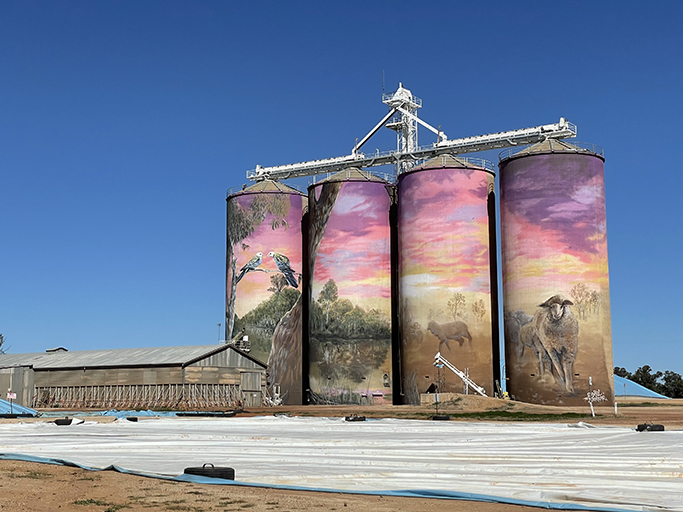
You can even camp here in the Thallon Recreation Camping Grounds if you would like to spend more time admiring this beautiful work of art. Amenities include power, water, free hot showers, flushing toilets, bins (recycling and landfill), plus a dump point.
Disappointingly you can’t see the whole image from here – not when we visited anyway, as there is a large tarpaulin covered pile of what I assume is grain blocking the view. The silos are in a working yard owned by Grain Corp, so for safety reasons people are asked not to enter the area. If you drive around to Noondoo Thallon Road you can see a bit better, as we were there on a weekend and there was not a sole in sight I did snap a couple of pics from this side.
Portland
Location: Williwa Street
Artist: Guido van Helten
Completed: 2018
Portland was home to Australia’s first cement works, supplier of top-quality cement to the busy Sydney building industry until 1991. The artist Guido van Helten, who’s large scale photorealistic portraits can be found around the world, is famous for capturing the heart and soul of the people he paints; this mural is no exception.
Guido visited with many Portland locals who shared their photos, newspaper clippings and recollections, piecing together a history of the town, the cement works and its impact on the community. Six former employees of the cement works are depicted on the silos, represent the towns strong connection to the site.
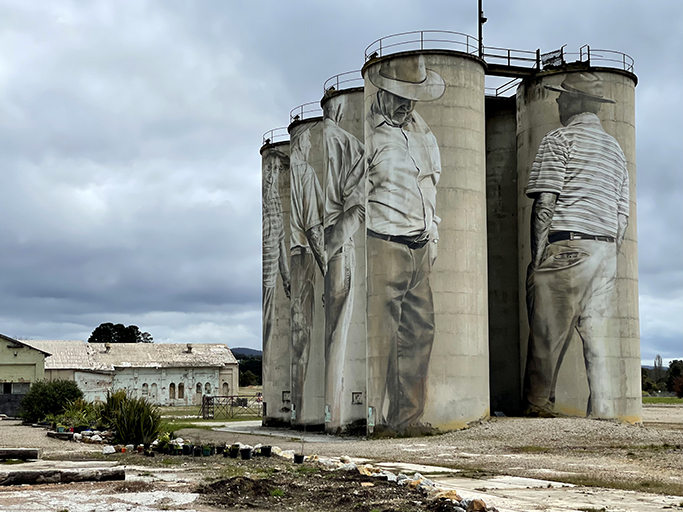
Portland’s painted silos are located right in the centre of town with plenty of off-street parking available. The silos are accessible seven days a week, and if you arrive between 10.00am and 5.00pm you can walk right up to and around them. If you are passing by when the gates are shut, you can still get a good look– just not the all area access pass you get during the day.
Glebe Island
Location: Glebe Island, Balmain
Completed: 2000
While not listed on any Silo Art trails, in my book these impressive urban silos still qualify.
Glebe Island grain elevator and concrete silos started operation in 1921 and continued bulk handling of grain until 1990 when the wheat terminal was moved to Port Kembla and the Balmain wharf was remodelled for container cargo. Some silos were demolished, while from 1991 several were used as a bulk cement terminal.
In the lead up to the Sydney Olympics in 2000, the now heritage listed silos were painted to mimic Grecian columns and a massive structure attached on top to take advertising. Although unsubstantiated, it is often referred to as ‘the largest billboard in the southern hemisphere’.
